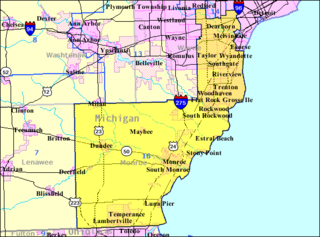| Vermont's 1st congressional district | |
|---|---|
| Obsolete district | |
| Created | 1791 1821 1825 |
| Eliminated | 1810 1820 1930 |
| Years active | 1791–1813 1821–1823 1825–1933 |
Vermont's 1st congressional district is an obsolete district. Vermont currently has one representative to the United States House of Representatives, elected statewide at-large. Until 1933, however, the state used to have multiple seats spread out into geographic districts. During that time, the first district elected its own representative.
These are tables of congressional delegations from Vermont to the United States Senate and United States House of Representatives.
From its statehood in 1816 until 1823, Indiana was allocated only one representative, who was elected at-large. During the 43rd Congress, from 1873 to 1875, Indiana elected three of its thirteen representatives to the United States House of Representatives at-large from the entire state.
Beginning from its inception into statehood, New Jersey elected its representatives at-large instead of from individual districts. This continued for most years until 1843, with the exception of the years 1799-1801, and 1813-1815 when they were elected in districts. After 1843, New Jersey returned to district representation. Four at-large representatives were elected in 1789 until 1793 when a 5th representative was added. 6 seats were allocated beginning in 1803, continuing until at-large representation ceased in 1843.
Michigan's at-large congressional district may refer to a few different occasions when a statewide at-large district was used for elections to the United States House of Representatives from Michigan.
Massachusetts's at-large congressional seat is an obsolete construct only used during the 1792–1793 United States House of Representatives elections in Massachusetts. In that election, one of the state's then-14 representatives to the U.S. House was elected statewide at-large. At that time, the U.S. state of Massachusetts included the District of Maine.

Michigan's 16th congressional district is an obsolete United States congressional district in Michigan. It covered the communities of Dearborn, Downriver and Monroe County.
Michigan's 19th congressional district is an obsolete United States congressional district in Michigan. The first candidate elected from the newly created district was Billie S. Farnum in 1964. It was eliminated as a result of the redistricting cycle after the 1980 census.

From statehood in 1896 through the creation of a second district in 1913, Utah sent one representative to the United States House of Representatives who was elected at-large statewide.
From 1793 to 1827 and again from 1829 to 1845, Georgia elected all its Representatives in Congress from a single multi-member at-large congressional district.
Arkansas's at-large congressional district was a congressional district for the United States House of Representatives in Arkansas from 1836 to 1885.
Florida's at-large congressional district may refer to a few different occasions when a statewide at-large district was used for elections to the United States House of Representatives from Florida. The district is obsolete.
From December 28, 1846, to March 3, 1847, the new state of Iowa was represented in the United States House of Representatives by two representatives who had been elected on a statewide basis, rather than by districts.
On three occasions in New York history, some members of the United States House of Representatives were elected statewide at-large. This was due to an increase of the number of representatives after the previous federal census, and the failure of the State Legislature to re-apportion the congressional districts in time for the next election.
During the 35th through 37th Congresses, Minnesota elected its two members of the United States House of Representatives at-large statewide on a general ticket. Minnesota then elected a member to an at-large seat 1913-1915, with the remaining nine representatives elected in districts. Minnesota elected all its members at large for the 73rd Congress, ending the practice two years later.
From statehood in 1867 until 1883, Nebraska had only one congressional district. Its representative was elected at-large statewide.
Vermont's 2nd congressional district is an obsolete district. It was created upon Vermont's admission as the 14th state in 1791. It was eliminated after the 1930 census. Its last congressman was Ernest W. Gibson, who was redistricted into the at-large district.
Vermont's 3rd congressional district is an obsolete district. It was created in 1803. It was eliminated after the 1880 census. Its last congressman was William W. Grout.
Vermont's 5th congressional district is an obsolete district. It was created in 1821. It was eliminated after the 1840 census. Its last congressman was John Mattocks.
Vermont's 6th congressional district is an obsolete district.